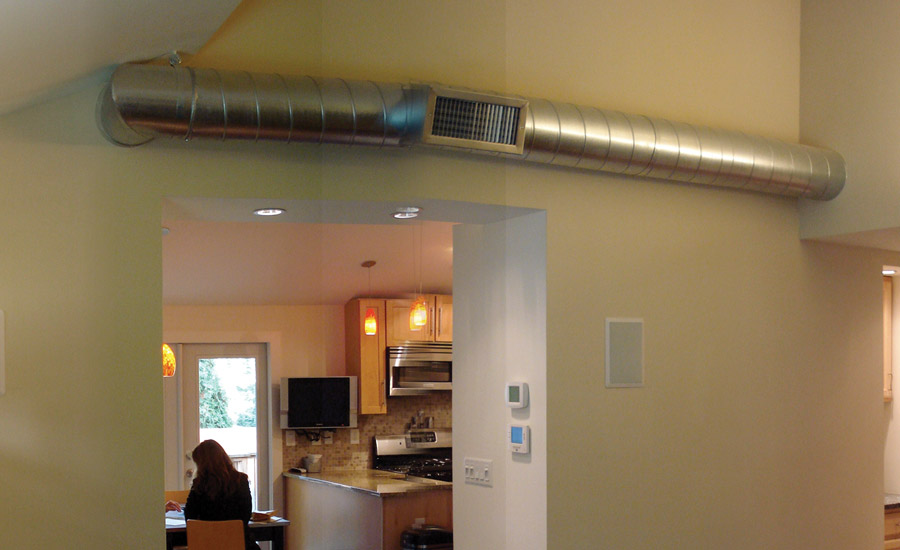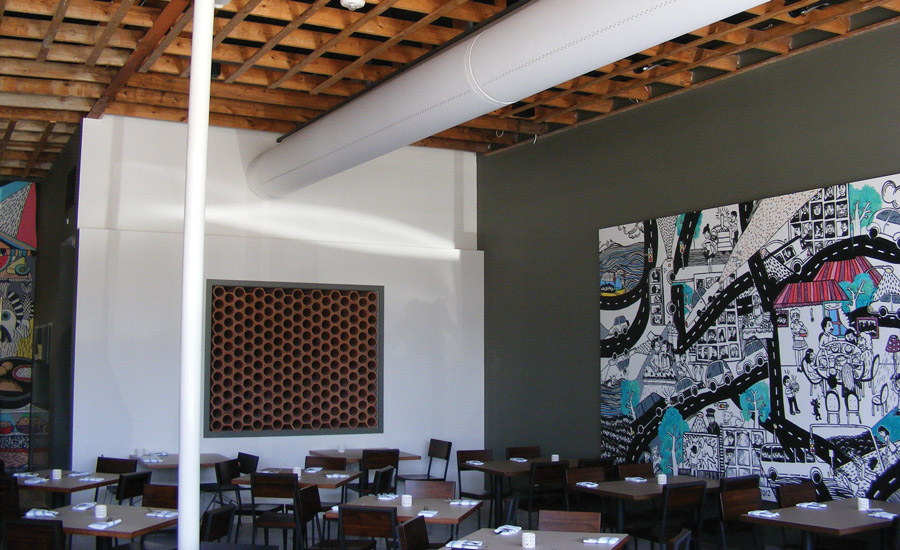While big-box retailers have installed HVAC ductwork in the conditioned space for many years, exposed ductwork is a relatively new phenomenon for the light commercial market. And, as small businesses increasingly embrace the “industrial” and spacious look exposed ductwork creates, contractors are warming up to the idea, as well.
DESIGNER DUCTWORK
David Richardson, curriculum developer and trainer at the National Comfort Institute (NCI), is a vocal fan of exposed ductwork. “It’s in a location where it ought to be — inside a building instead of hidden,” he explained, adding that the accessibility and visibility of exposed ductwork often facilitates a quality installation.
“When your work is visible, you’re going to be more conscientious of what that work looks like — you’ve upped the game,” Richardson said. “The other thing I like is accessibility from an air-balancing standpoint. There’s a higher likelihood of that system being commissioned properly.”
Greg DuChane, sales leader for retail restaurant national accounts at Trane, a brand of Ingersoll Rand, said exposed ductwork simplifies the work of an air balancer.
“The air balancer can simply climb a ladder to access the ductwork rather than climbing into the ceiling and moving insulation to make their final adjustments,” he said. “It’s right there for them, which makes everything easier.”
Exposed ducts can also be a more cost-effective choice for the building owner, DuChane said. “In a restaurant, it’s in the conditioned space now, and you don’t have all that insulation, which helps save on the cost.”
John Reints, a professional engineer and design-and-build contractor, said leaving ductwork exposed is definitely becoming the new normal in the light commercial market.
“I’d say, in general, the construction industry has reached the tipping point where the majority is starting to go with the exposed approach all the way to the deck,” he said. “It works better, and it saves on construction costs. And, surprisingly, it installs quite easily. Ductwork is 80 percent labor and 20 percent materials, so you spend a little more on materials, but less on labor.”
MATERIALS MATTER
Whereas rectangular ductwork has been popular in the past in finished ceilings, round ductwork is becoming a popular choice in exposed installations due to its size, ease of installation, and clean appearance.
“I will point out that round ductwork is acoustically superior,” Reints said. “Rectangular has a bass drum effect, and it’s noisy, while round ductwork is very, very quiet. The round shape also gives you a better flow that wastes less energy.”
However, metal ductwork may not always be the right choice. Since it’s in the conditioned space and isn’t insulated, condensation can occur during the summer months if humidity levels aren’t managed.
“As long as there is humidity control, it doesn’t sweat,” DuChane said. “They have to be careful because if they’re not managing moisture, it could become a problem.”
Fabric ducts are also becoming increasingly popular in installations where the ductwork is left exposed in the conditioned space.
Nick Kaufmann, director of manufacturing and engineering, DuctSox Corp., said the benefits of fabric ductwork are numerous.
“It provides more even air dispersion than metal ductwork,” he said. “Linear vents typically span the entire length of the fabric duct run. … There is also significant savings on install time and maintenance costs versus metal duct.”
Additionally, fabric ducts can be easily customized to fit the needs and décor of the building in which it is installed.
“There are a variety of suspension systems, porous and non-porous colored fabrics, and venting options,” Kaufmann said. “You can also personalize fabric ductwork with full-color company logos or lettering.”
Business owners have also found ways to customize their metal ductwork, going so far as to request it be painted certain colors during installation. Others have added logos and other designs after installation.
“I’ve seen all sorts of colors,” DuChane said. “One customer specified ‘chestnut beige’ in his plans.”
NOT FOR EVERYONE
While many contractors prefer installing and servicing exposed ductwork, not everyone is a fan. Carter Stanfield, director of the air conditioning technology department at Athens Technical College in Athens, Georgia, and author of “Fundamentals of HVAC/R,” sees two disadvantages.
“If your duct is on display, it has to be pretty,” he said. “That may actually be an advantage for the customer, but it can put a little more pressure on the contractor.”
Second, Stanfield said, is the potential condensation issue. “In theory, that shouldn’t happen because it’s in a conditioned space. But, if it’s a little hotter and higher humidity where the duct is, you can sometimes get condensation. Also, when the a/c is first turned on, if the building is hot and muggy, you’ll definitely get condensation. Nobody wants condensation dripping into their salad.”
Robin Boyd, HVAC advisor and consultant at H-VAC Consulting, also pointed out the added pressure to make sure such ductwork is visually appealing.
“If an establishment doesn’t keep its store clean by not vacuuming the tops of the ductwork, then it looks bad,” he said. “Obviously, if you have exposed ducting, it, like the rest of the building, must be cleaned periodically. If there’s a condensate issue causing rusting, a humidity problem, or even maybe an airflow problem, it’ll show. Rusting is an indication that something needs to be addressed.”
In the end, choosing the right ductwork for the job is a decision to be made on an individual basis while taking all factors into consideration.
“The average person walking into your business takes it for what it is and doesn’t even consider that it could have been done any other way,” said Rodney Koop, founder of The New Flat Rate Inc. “So, build it for what you want it to look and feel like according to your budget.”
Publication date: 9/21/2015
Want more HVAC industry news and information? Join The NEWS on Facebook, Twitter, and LinkedIn today!














